Many moons ago (by which we mean until the mid-90s), there existed mystical Shangri-La’s in shopping malls all across Americas, where quarters flowed, laughter resounded, and countless beefs were settled by joysticks and four buttons. Where the latest games were at your beck and call, and where no one asked for your ID before playing Mortal Kombat. We speak, of course, about the long forgottenarcade.
Okay, maybe they weren’t quite as great as we remembered, but if there are three things we at Popblerd! love, it’s nostalgia, the 80s, and lists. So what better way to combine those passions than to count down our favorite arcade games of the medium’s golden age. These are the games that filled our young minds with wonder, that opened wide the doors to crippling video game addictions, and that shut us the hell up so our parents could shop.
#15: Pole Position
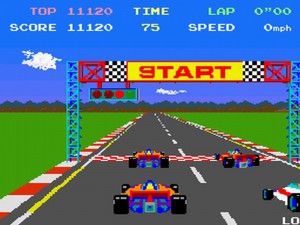 Even today, a mainstay of arcade and console games revolve around car racing. It’s an alluring fantasy, particularly when directed at youth who have yet to acquire a license. Pole Position is the grandaddy of that entire genre of gaming.
Even today, a mainstay of arcade and console games revolve around car racing. It’s an alluring fantasy, particularly when directed at youth who have yet to acquire a license. Pole Position is the grandaddy of that entire genre of gaming.
The concept is simple – you’re driving a race car. Your objective is to win. That’s about as complicated as it gets. But in addition to being one of the first driving-oriented games, Pole Position was even more alluring on account of its design. Players had to make use of a functioning steerwheel, gas pedal, and gear shift to control their car. Even better was if your local arcade had one of the sit-down cabinets that immersed you in a mock up interior of a race car. There was even a seatbelt as I recall. Pole Position was also perhaps the beginning of my crippling fear of manual transmission.
But I digress. Pole Position was the highest grossing video game of 1983. Although the original isn’t around much these days, even in 2012 an arcade isn’t an arcade without a racing game, and this is Pole Position’s lasting legacy on gaming. The game also spawned a cartoon spinoff that lasted all of three months. – Dr. Gonzo
#14: Centipede
The very first real wave of post-pinball arcade games, forever referred to as “video games,” was primarily monochrome wire-frame-based stuff such as Space Invaders, Asteroids, and Missile Command. While these are all great games, the generation that immediately followed these began to feature color graphics and contains a contingent of video games that remain all-time classics. This second wave, if you will, includes familiar favorites like Pac-Man, Galaga, and the game of topic here, Centipede.
The premise is simple: you are an archer (a confusing graphic because he looked a lot more like, er, some kind of bug’s head shooting a stinger or something), defending a 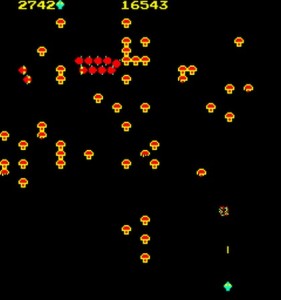 garden against a pest infestation, with the primary offender being a centipede. Well, apparently a giant freaking centipede, because it pursued you relentlessly, and if it caught up to you, well, it was curtains for your little archer.
garden against a pest infestation, with the primary offender being a centipede. Well, apparently a giant freaking centipede, because it pursued you relentlessly, and if it caught up to you, well, it was curtains for your little archer.
What was always great about Centipede was that, unlike Pac-Man and some of the other games of the day, there were no patterns to memorize that would allow you to always overcome your foes. Oh, no. Your performance was based straight-up on reaction time and hand-eye coordination, making this one of the games that separated the arcade heroes from the wannabes. If you split that centipede too early up high in the later levels, you were hopelessly screwed. While you tried to divide your time across both ends of the screen chasing down the multiple horrors you had just unleashed, the now warp-speed spider and flea attacks would make this type of movement nearly impossible. Nope, you either learned how to line up some mushrooms and funnel that monster right down the tube so you could finish it off nearly all at once, or get ready to die and try that level over. Ouch.
Add in that your method of control was the awesomeness of a rollerball, giving you excellent detailed control over your archer (and also resulting in a crapload of pinched palms at the edge for the uninitiated), and it made Centipede one of the most fast-and-furious arcade games you could lay hands on for a mere quarter.
A year later, Atari followed it up with Millipede, which was essentially the same game but with more advanced features, such as mushroom growth, DDT bombs, and new bug types a-plenty. Well, that and they added an extra couple of legs per body segment just to make things extra creepy. Way to give me nightmares, Atari. I’ll send you my therapy bill. – Grez
#13: The Simpsons
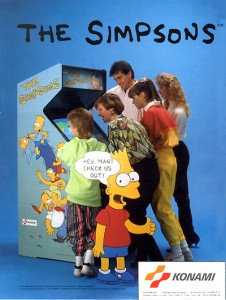 Konami owned the late 80’s/early 90’s, coming out with Teenage Mutant Ninja Turtles (which also made our list!), The X-Men and The Simpsons in a span of 4 years. They all had a similar formula to them: Extremely fun and addicting. In The Simpsons you can play as Homer, Marge, Bart or Lisa as they try to rescue a kidnapped Maggie. And while the aforementioned games all had a bunch of thugs you beat up throughout the stage and a boss at the end the Simpsons had something no other game until then had. When playing with another player you could team up with another player to do special moves.
Konami owned the late 80’s/early 90’s, coming out with Teenage Mutant Ninja Turtles (which also made our list!), The X-Men and The Simpsons in a span of 4 years. They all had a similar formula to them: Extremely fun and addicting. In The Simpsons you can play as Homer, Marge, Bart or Lisa as they try to rescue a kidnapped Maggie. And while the aforementioned games all had a bunch of thugs you beat up throughout the stage and a boss at the end the Simpsons had something no other game until then had. When playing with another player you could team up with another player to do special moves.
The graphics were as good at the cartoon, the levels were all very different and there were enough moves to keep things interesting throughout. The Simpsons arcade game came out when the show was reaching the height of its popularity and I remember waiting in line to play this at the bowling alley. I word of warning; do not think that since the Simpsons arcade game is great that the platform games are great as well. Bart vs. The Space Mutants, The Itchy and Scratchy Game, The Simpsons Road Rage and the TWENTY THREE other games almost all range from terrible to unplayable. – Jay
#12: Space Invaders
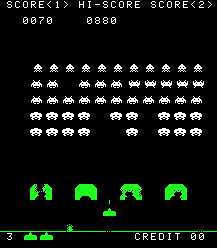 I’m old school…even though I’ve had four or five game systems since I was a kid, my favorite games are still the chestnuts: Pac-Man, Donkey Kong, and good old Space Invaders. There are no flashy graphics, no life-like simulations. Just you, a couple of cannons, and a bunch of aliens that you need to obliterate. Nope, the aliens don’t look realistic. Hell, the cannons don’t even totally look realistic. Keep in mind that these graphics were embarrassing even for the early Eighties. Nevertheless, if you wanted to take out your aggression on that bully who took your lunch money back in the 4th grade, you grabbed some quarters and took some aliens out. Mom or Dad had a hard day at work? You might have been able to convince them to pick up the other joystick and fuck some aliens up too. Stress relief for the whole family. That’s what “Space Invaders” was. Although if aliens actually invaded the Earth, you’d probably be shit out of luck unless joysticks and cannons dropped out of the sky. – Blerd
I’m old school…even though I’ve had four or five game systems since I was a kid, my favorite games are still the chestnuts: Pac-Man, Donkey Kong, and good old Space Invaders. There are no flashy graphics, no life-like simulations. Just you, a couple of cannons, and a bunch of aliens that you need to obliterate. Nope, the aliens don’t look realistic. Hell, the cannons don’t even totally look realistic. Keep in mind that these graphics were embarrassing even for the early Eighties. Nevertheless, if you wanted to take out your aggression on that bully who took your lunch money back in the 4th grade, you grabbed some quarters and took some aliens out. Mom or Dad had a hard day at work? You might have been able to convince them to pick up the other joystick and fuck some aliens up too. Stress relief for the whole family. That’s what “Space Invaders” was. Although if aliens actually invaded the Earth, you’d probably be shit out of luck unless joysticks and cannons dropped out of the sky. – Blerd
#11: Marvel vs. Capcom 2
Street Fighter 2 brought fighting games into the mainstream, Mortal Kombat took it to the next level, a billion other fighting games came out and then Marvel Vs. Capcom 2 perfected it. It was a perfect combination of fast gameplay like Mortal Kombat, large combo’s like Killer Instinct and traditional moves like Street Fighter. Only you can play 3 vs 3 and choose from 56 characters. 56!
On the Marvel side you got to play from all of your favorites like Wolverine, Spider-man, Iron Man and The Hulk, while the Capcom side had characters from Street Fighter, Darkstalkers, Mega Man, Strider, Resident Evil and even Bionic Commando. I remember having a bad guy team of Venom, Sabretooth and Magneto and a good guy team team of Strider, Bionic Commando and Captain America. The gameplay went from the 6-button format of Street Fighter down to 4 buttons so it was easier for casual players to pick up, but kept all the special moves and combinations for the more intense gamer.
The first and by far the best home version came out for Dreamcast in 2000 and in very limited runs on PS2 and Xbox in 2002. The poor souls who didn’t have an arcade near them or a Dreamcast had to wait until 2009 for this to come out on XBox 360 and PS3 networks. If you haven’t played this before, grab a copy, while some games seem slow or dated this one holds up and is still as fun as it ever was. – Jay
#10: Asteroids
 This was the great thing about making a game set in space back in the early days of the video arcade: by defining the setting of a game in a place where the absence of anything is its primary characteristic, you can pass off a plain back background as a design choice rather than a practical necessity. This is why what many consider to be the first video game was a thing called Spacewar, and why some of the most popular games in the early days of arcades were games like Space Invaders, Galaxian, and, of course, Asteroids.
This was the great thing about making a game set in space back in the early days of the video arcade: by defining the setting of a game in a place where the absence of anything is its primary characteristic, you can pass off a plain back background as a design choice rather than a practical necessity. This is why what many consider to be the first video game was a thing called Spacewar, and why some of the most popular games in the early days of arcades were games like Space Invaders, Galaxian, and, of course, Asteroids.
What set Asteroids apart from the rest was that it actually used all of that space. Rather than restricting the player to a strict straight line in which to travel, Asteroids offered the whole screen. Rather than the all-too-simple threat of death from above, Asteroids offered 360 degrees of terror. And just when you thought you had the threat handled — the name of the game was Asteroids, after all — it threw in a bona fide enemy to show up and start shooting at you. Those confounded UFOs always made things difficult, and always at precisely the wrong time.
It was easy to forget the game was in black and white, because it took so much attention and skill just to stay alive long enough to rack up anything approaching a high score. Sure, there were ways to “break” it, ways that record-holders found to easily stay alive for days at a time, but for those of us just in it to have a little fun, it was one of the most intense experiences imaginable. Even as years passed and games got brighter, more colorful, and more advanced, Asteroids still had a place in arcades for much of the ’80s, a relic of the past perhaps, but always a reliable source of classic arcade fun. Not bad for a bunch of white lines on a black screen. – Mike S.
#9: Double Dragon
Double Dragon was the first game I didn’t want my parents to see me playing.
This game was violent. It was intense. These things were clear before you even put in a quarter. Over and over, you watched a woman get punched in the stomach and carted off by a group of thugs, as you stood there, helpless to do anything about it as long as your pockets were empty. I can’t remember how many times I watched that intro. It was intriguing, a little bit horrifying, and far grittier than any video game I’d ever seen.
And then playing it matched that impression step for step. Punches and kicks land with sickening, squishy crunches. Bats can be picked up and swung. Knives can be thrown for an instant kill. And then, there was the secret weapon of the Double Dragon player, the elbow. Master the art of the elbow — just a matter of turning your back to the enemy and hitting the “punch” and “kick” buttons at the same time — and you can blow through some of the toughest scenarios in a matter of minutes. Bring a friend, and you can even gang up on hapless enemies stupid enough to turn their back to one of you.
Double Dragon didn’t age well; there have been better brawlers since (X-Men, The Simpsons, and especially Teenage Mutant Ninja Turtles), and enemies who blink to indicate death seem horribly primitive when you’re ripping spines in Mortal Kombat. Still, at the time, it was a fascinating and violent display of just how far arcade games had come, and where they might go.
To the eyes of a child, it was intoxicating. – Mike S.
#8: Rampage
Rampage is one of the most simplistic and easy to understand games to stop off at the arcade and play. You and possibly two other players use oversized monsters to destroy buildings and eat humans. That’s it. There’s nothing else to it.
The charm is in the destruction (terror! and mayhem!). Who doesn’t want to destroy buildings and eat people in a video game? I’ll agree that the game play is maddeningly the same throughout with very few wrinkles as you go from city to city. But the action is fast-paced and the elements that make arcade games fun are all there. More fun with your friends? Check. Tangible goal? Check. Enough action for your quarter? Check.
The one negative is that players who enjoy finishing games probably won’t get much joy in beating Rampage. It’s more of an exercise in outlasting the game than really beating it. You go to 128 cities in all and can do it up to five times. After you do it five times, the game resets and you start over. That’s it.
(One other possible negative is that all of the home generations were pretty bad. There was a GameCube and PS2 version that came out that wasn’t the same as the original and it was fun. It was also ported over to the Wii. But trying to play the original Rampage on the home systems was a disappointing experience.) – GG
#7: Mortal Kombat 3
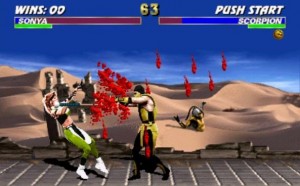 The first Mortal Kombat took the world (and more importantly US Congress and conservative watchdog groups) by storm with its over-the-top violence and gore, bringing the word “Fatality!” into the vernacular of young boys everywhere and showing how cool misspelling things can be! But want to know a secret? Compared to Street Fighter II, it was kind of an awful and really simplistic fighting game.
The first Mortal Kombat took the world (and more importantly US Congress and conservative watchdog groups) by storm with its over-the-top violence and gore, bringing the word “Fatality!” into the vernacular of young boys everywhere and showing how cool misspelling things can be! But want to know a secret? Compared to Street Fighter II, it was kind of an awful and really simplistic fighting game.
It took them three tries, but the arrival of MK3 marked the series’ evolution into an actually complex and nuanced fighter. The new additions were plentiful: run meters to counter “turtles” (those jerks who spend the whole time backstepping and blocking); canned combos to reward those who took the time to learn the game; a better focus on juggling your opponent in the air; multi-tiered and interactive levels; and the now infamous Animalities, which let you turn into an animal and then violently murder your opponent. Plus, the game introduced a slew of new characters to the game’s every growing roster, including robots Cyrax, Kabal, and Sektor; Native American warrior Nightwolf; riot officer Stryker; and Sheeva and Sindel, almost doubling the game’s number of females! True, a few classics missed the cut (no Johnny Cage!?) but they would find themselves back in the updated Ultimate MK3.
Everything else we loved remained, however. The fatalities were as brutal as ever, the graphics still featured digitized real life actors, and you could still get lost in the game’s ridiculous lore. Plus, as an eight year old, nothing felt as cool as playing a game you knew your parents wouldn’t let you. Ah, to be a young rebel again! – Stephen
#6: Galaga
What would you give for a leg up? If you knew you could come back from death twice, would you commit suicide for a competitive advantage?
This is essentially the question Galaga asks every time you put in a quarter. Sure, you can play with one ship, and you can do just fine — avoid the bullets, pick off the baddies, and move on to the next stage. If you really want to rack up the scores, though, you have to let yourself get captured, which essentially takes away one of your lives. Destroy the “boss Galaga” who captured your ship while it’s moving, however, and your old ship turns into a sidecar, essentially turning your piddly little one-shot-at-a-time ship into a two-turreted killing machine.
While making your ship bigger does make it easier to hit, this minor drawback is more than made up for by the doubling of the firepower. An enemy caught in between two fired bullets at any point will almost always move just enough to hit one before they pass; what looks like two bullets next to each other almost functions as a wide beam since these little hostile aliens just can’t help themselves from looping and diving all over the place. And the bonus stages? It’s almost not even worth trying for a perfect score without that second ship attached.
Galaga isn’t the most original game — it’s not even the first in its own franchise — nor does it offer hidden nuances as a bonus for playing longer. No, it’s really a matter of that one simple gameplay tweak making for an experience far deeper than any of its contemporaries could hope to offer. It’s the best of the “sitting on the bottom of the screen and shooting up at bad guys” games, and it still has a place in any decent arcade (often alongside the equally-classic Ms. Pac-Man).
Getting a high score in Galaga meant you made the ultimate sacrifice, and then justified your choice to do so by fulfilling the potential offered by that choice. What could possibly be more satisfying? – Mike S.
#5: NBA Jam
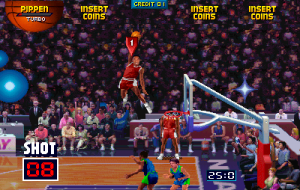 Many extremely popular video games aren’t extremely difficult to play. It makes sense. If you want a more casual audience of gamers to play your game, you have to make it easy enough to figure out after a game or two and yet, there needs to be a reason for more of the hardcore fans to keep playing. Make it too difficult and it won’t be popular enough to become a success. Make it too easy and people will stop playing it fairly early on. This was what made NBA Jam great.
Many extremely popular video games aren’t extremely difficult to play. It makes sense. If you want a more casual audience of gamers to play your game, you have to make it easy enough to figure out after a game or two and yet, there needs to be a reason for more of the hardcore fans to keep playing. Make it too difficult and it won’t be popular enough to become a success. Make it too easy and people will stop playing it fairly early on. This was what made NBA Jam great.
In 1993, Midway secured the NBA license for a 2-on-2 dunkfest of a game. Mark Turmell designed the game and it was an immediate hit. It was also one of the more expensive games to play, considering it was either 25-50 cents per quarter or $1-2 per full game. The key to the game was to get “on fire”, which meant that your player scored three baskets in a row without allowing the other team to score. Once your player was on fire, you could pretty much hit any shot, including 3-pointers. The dunks were over the top with the announcer screaming catch phrases such as Mars Blackmon’s “Is it the shoes?” and “Boomshakalaka!”
While the original version was fun, my favorite version of the game was the sequel, the Tournament Edition. There was a cabinet at the local 7-11 near my high school and I’d go there after school every day to play a game or two to see if I could beat all of the teams. I was two teams away from the final team before the 7-11 replaced the cabinet. It was one of the saddest days of my life. The home systems couldn’t really recreate the charm, though they tried. It wasn’t until the latest generation systems put out a brand new version of NBA Jam that they perfected it. Rosters were updated to reflect the current NBA stars and none of the charm was lost. It’s still a really fun game to play.
(Michael Jordan wasn’t in any edition of the game as his license was deemed too expensive since he owned his own likeness. Charles Barkley would later follow suit as would Shaquille O’Neal. O’Neal were only in the original arcade version, while Barkley was in the original arcade and first SNES and Genesis version.) – GG
#4: Donkey Kong
Ah, here it is: the game that launched Nintendo’s career. Oh sure, they existed before “Stubborn Gorilla” (translated, sort of, to Donkey Kong) took off, but this is the game that defined the company. Don’t believe me? Name the most popular Nintendo character of all time. If you said anything other than “Mario,” then you should be kicked repeatedly in the crotch until you can no longer breed. For all of the rest of us who are still able to (theoretically) reproduce, we’re all firmly aware that Nintendo has worked the Mario character into the vast majority of its popular franchises like Mario Cart, Mario Party, Mario World, Super Mario Bros…seeing a pattern here? While the first time that he was actually named “Mario” in an actual game (they did print this name on the Donkey Kong cabinet, but it did not appear in the game) came from the original Mario Bros game (note: not “Super” — just “Mario Bros”) — where the player got to whack turtles and crabs and other baddies with Mario’s (and Luigi’s) head to knock them out — it was in Donkey Kong where he first appeared, named simply as “Jumpman.” And they’ve been milking the crap out of him ever since.
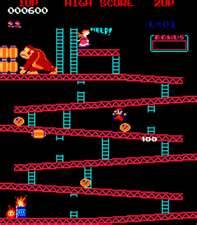 This is ok, really. I mean, Mario’s a pretty unique character, and a loveable guy who just wants to get the girl. Who can’t identify with that? Ok, maybe girls and gay guys. But still, everyone at least gets it. Besides, he not only runs around smashing self-aware balls of fire with a giant hammer; he also wears a jaunty cap and flaunts a porn ‘stache and that takes balls.
This is ok, really. I mean, Mario’s a pretty unique character, and a loveable guy who just wants to get the girl. Who can’t identify with that? Ok, maybe girls and gay guys. But still, everyone at least gets it. Besides, he not only runs around smashing self-aware balls of fire with a giant hammer; he also wears a jaunty cap and flaunts a porn ‘stache and that takes balls.
When Donkey Kong was released in 1981, it truly represented very advanced graphics for its day and age. The on-screen characters were distinctive and attractive (enough so that after the game’s success, plush dolls, breakfast cereal, and action figures appeared), and animations provided comic moments not previously seen in arcade games. Beyond that, the game was one of the first to feature four distinctively different playing screens and situations for the player to deal with (Ramps, Rivets, Elevators, and Cement Factory), granting it an continued interest level and replayability factor that most other games of the day couldn’t match. It’s also credited with being the second true platform game (the first being Space Panic), but the first one to feature jumping. Games in this genre continue to be churned out by major software houses and indie companies alike, and they all have Donkey Kong to thank for it.
It should probably also be noted that Donkey Kong was the subject of one of the better (and I fully realize that “better” is a relative term here) songs on the Buckner & Garcia arcade game tribute album, Pac Man Fever (I was a proud owner of this on vinyl as a kid). The song is entitled “Do The Donkey Kong.” I’m certain that this refers to a dance or something, but to the best of my knowledge it never took off and I have no idea how to do it (this is a good thing for all involved). But to know that it was popular enough to justify Columbia Records funding publishing a song about it says a ton about its cultural significance in 1981. -Grez
#3: Street Fighter 2
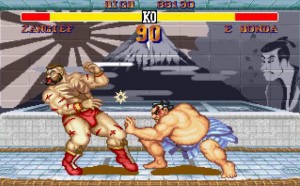 Of all the memories I have that revolve around Street Fighter II in the arcades, two stick out the most:
Of all the memories I have that revolve around Street Fighter II in the arcades, two stick out the most:
1. No game drew a crowd like this one.
2. Someone was always Chun Li.
The success of Street Fighter II was that it was a social experience. There was nothing at that point quite like seeing two masters of the game duking it out in at a machine, trying to settle the long-standing question of whether Ken or Chun Li was a stronger character. Nothing, that is, other than the unknown who took on the winner, chose a known loser like Dhalsim, and crushed the supposed master. Street Fighter II was the epitome of “quarter-up” gaming, where anyone could take a crack at the guy who’d been on the machine for the last hour, and kick him off if they were good enough. It was a game where you could walk into the arcade and pay a quarter for two hours of play if you were good enough.
Street Fighter II was colorful, it was loud, and it was shockingly balanced. For every move there was a countermove, for every countermove an alternate strategy. Practice and skill were always king, but even a complete newbie could occasionally find success spamming the “fierce kick” button. Even when you lost, you had an idea of what you could do to get better.
Street Fighter II lost its way a bit when it tried to expand the roster with characters like overpowered final boss M. Bison and oversexed commando Cammy; it slowly became more about the spectacle than the competition. Still, for what it was when it arrived and for the ideal it came to represent as scores of imitators tried to usurp its throne, there is simply no denying its importance, nor its influence. – Mike S.
#2: Teenage Mutant Ninja Turtles
Through the communal effort of high score chasing and the joy of teaming up with (or beating up on) your friends, classic arcade games all rely on some form of social interaction. But many of those interactions were limited in the early days, with only one or two able to play at a time and the rest forming an audience/peanut gallery of commentary. Even then, most games relied entirely on competition: who could score more, who could beat who? What were friends who didn’t want to foster rivalries to do?
Konami had the answer in the late 80’s, with a string of fantastic four-player beat ’em ups, which pit you and three friends against endless waves of enemies and bosses. It’s hard to pick a favorite among such a classic roster as X-Men and The Simpsons, but I think most can agree that the Teenage Mutant Ninja Turtles reigns as the pinnacle of the late 80s arcade scene. No arcade was complete without the digitized theme song blasting from some distant corner, and it was always the recipient of at least one quarter no matter where I went. Each character felt unique and important to the battle (even though I always loved Donatello’s low reach with his staff), and the boss fights were a test in teamwork, especially the final showdown with Shredder (if you could even make it that far).
That’s not to mean everything was roses; few things boil my blood as much as watching an oblivious friend scarf up the pizza I clearly needed for health or jump around aimlessly while a purple foot soldier held my arms back so his buddies could punch me in the gut. But whether it strengthened friendships or weakened them, one thing holds true; TMNT was the best damn beat ’em up ever. – Stephen
#1: Ms. Pac-Man
 While there were many blockbusters in the golden era of arcades, none permeated popular culture to quite the extent that Pac-Man did. A breakfast cereal (though to be fair, Donkey Kong had one too), a cartoon, storybooks, t-shirts, a Chef Boyardee pasta, any number of toys and knick-knacks, and of course, a top ten pop hit. These accolades are well deserved, and Pac-Man remains a classic. But when we’re talking about the game itself, it’s clear that Ms. Pac-Man was indeed his better half.
While there were many blockbusters in the golden era of arcades, none permeated popular culture to quite the extent that Pac-Man did. A breakfast cereal (though to be fair, Donkey Kong had one too), a cartoon, storybooks, t-shirts, a Chef Boyardee pasta, any number of toys and knick-knacks, and of course, a top ten pop hit. These accolades are well deserved, and Pac-Man remains a classic. But when we’re talking about the game itself, it’s clear that Ms. Pac-Man was indeed his better half.
Ms-Pac Man improved upon a successful formula, but didn’t go overboard with new bells and whistles (Bally Midway would save that kind of excess for 1984’s Pac Land). While there were some amusing vignettes between levels, and the pantry of bonus items had its own charm, what ekes Ms. Pac-Man over her husband is the gameplay. Ms. Pac-Man traverses each board more smoothly, and with slightly greater speed. Moreover, those pesky ghosts randomly move around the board, as opposed to the patterned paths that they took in the original game. Altogether, these tweaks add up to a more challenging, more exciting, and ultimately more fun game. Little wonder then, that it became the highest selling arcade cabinet in its day. If I were to own a video cabinet in my home that wasn’t Moonwalker, Ms. Pac-Man would surely be my first choice. (And let’s not forget – Ms. Pac-Man did stake her territory in the cereal bowl as well). – Dr. Gonzo


3 comments
GG says:
Jul 11, 2012
Love this list and had so much fun participating!
Grez says:
Jul 11, 2012
Yeah, I’m really happy with how this turned out…some great write-ups in here!
I’ve only come up with one really major oversight in the list: Spy Hunter. How can we not have Spy Hunter in here? We may have to make this sixteen and add that bad boy on. 😉
Schiller says:
Jul 12, 2012
Spy Hunter’s a good one. I think Smash TV should be in there somewhere, too, but start asking me which one it would replace, and my head might explode.